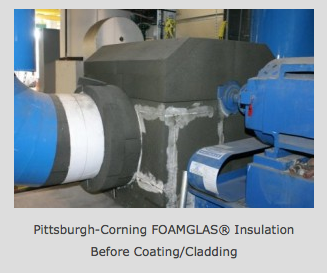By joetinger on March 21, 2011
Minimizing fire hazard from insulation is very straightforward — if you have the money.
Insulation is nothing more than a large number of air pockets that are held in place by some type of material. For high temperature systems, these materials may consist of mineral fibers, compressed particles (calcium silicate or perlite) or cellular glass (FOAMGLAS® Insulation).

Because of the way the material is produced, the air pockets in the cellular glass material are not connected so that any fluid that enters the material remains isolated near the leak point — preventing the type of autoignition that causes fires. Weep holes are often drilled through the material to allow pooled fluid to drain out which further reduces the fire hazard (unless of course the drain is right over an ignition source).
Unfortunately, because cellular glass is rigid, it must be purchased in either blocks or shapes to fit specific components like valves or piping T’s, which significantly increases the material cost. Installation costs are also higher because of the onsite cutting required to fit one rigid component to another.
The next posting will focus on how to minimize the cost without increasing the hazard.
|
